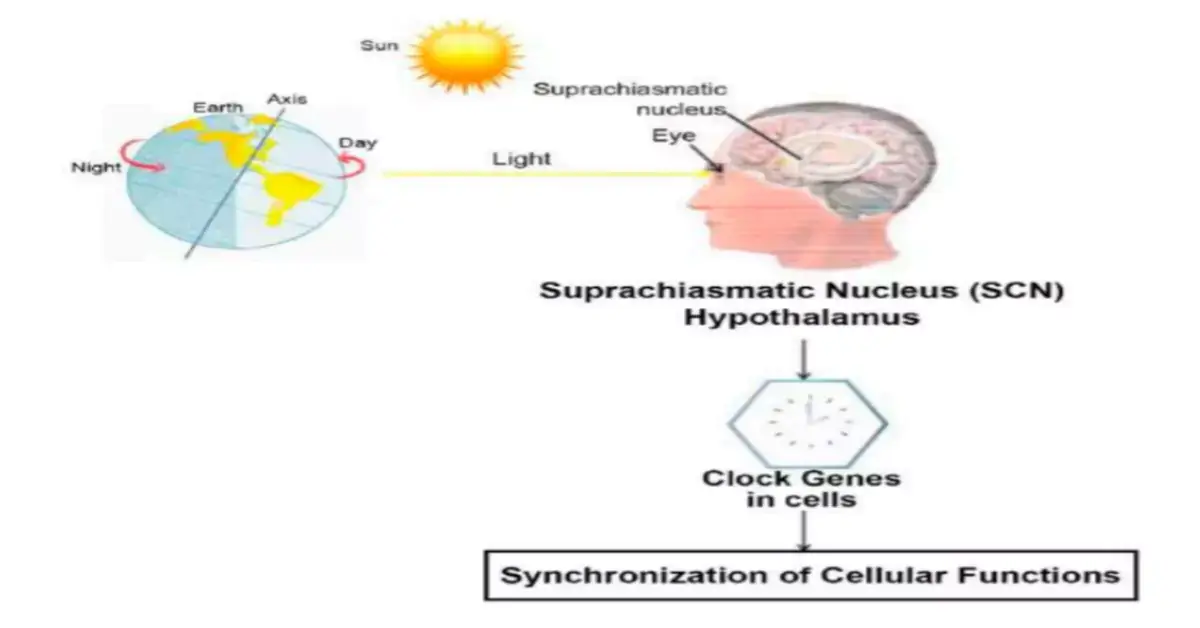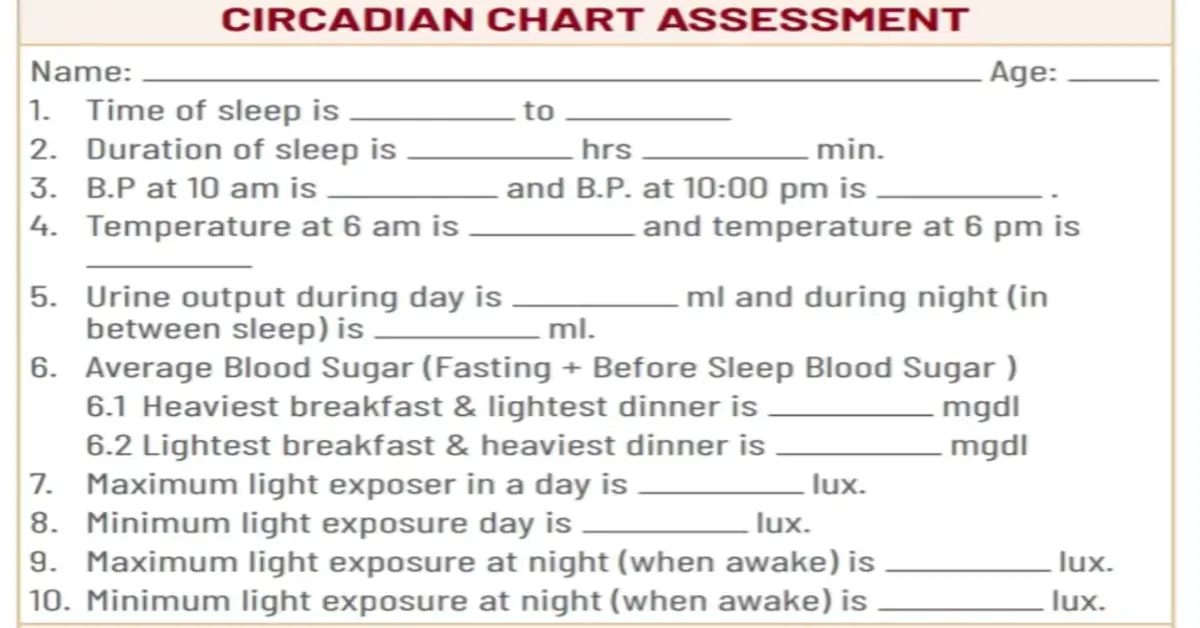The circadian rhythm is a 24-hour cycle that regulates physical, mental, and behavioral changes. This natural process is related to light and darkness. Circadian rhythms affect all living things, including animals, plants, and microorganisms. Being awake during the day and sleeping at night is an example of a circadian rhythm. Circadian rhythms are synchronized with a biological clock in the brain, which is directly influenced by light and darkness. All multicellular organisms, including humans, use a biological clock to regulate their circadian rhythm.
Table of Contents
Circadian Rhythm in Ayurveda
There is special mention of “Dinacharya” in Ayurveda, circadian clock or “Dinacharya” which means activity. Routine plays an important role in controlling various metabolic processes of the body, such as digestion, absorption, and assimilation. Routine plays an important role in our health and longevity.
Ayurveda has a special mention of the Tridosha Chakra, which explains the circadian rhythm. Vata, Pitta, and Kapha (Tridosha) regulate our bodily functions, just as the Moon, Sun, and Vayu are responsible for the balance of our Earth’s universe.
The Role of Circadian Rhythms in Our Lives
Circadian rhythms govern our sleeping and waking patterns. It is specifically related to the presence or absence of light. Our brain secretes hormones in response to environmental changes, which influence changes in body temperature to promote alertness or the need for rest.
Understanding an Infant’s Circadian Clock
The circadian system in newborns matures slowly after birth. In newborns, sleep-wake cycle rhythms or hormone production usually develop between 1 and 3 months of age. In newborn babies, the body registers daytime when the eyes are open and nighttime when the eyes are closed.

Sleep requires night, meaning darkness. Darkness stimulates the pineal gland in the brain to produce the hormone melatonin, a hormone essential for regulating circadian rhythms and sleep. Light also stimulates the secretion of the hormone cortisol. Which is a hormone associated with alertness. Adjustment of circadian rhythms in newborns to the puer cycle can take up to months.
The Earth rotates on its axis 24 hours a day and revolves around the Sun, resulting in 12 hours of light (day) and 12 hours of darkness (night). This light and dark is absorbed by the eyes and sent to the suprachiasmatic nucleus, which then communicates with the body’s cells.
The amount of this light is continuously recorded by the clocks inside the cells. As a result, there is a continuous process. Diminishing light at night increases the production of melatonin, which helps in restful sleep.
Light illuminates and controls both our external and internal worlds. If you wake up in the middle of the night and turn on bright lights, the brain responds by reducing melatonin production and putting you into an alert state. The brain stimulates the production of different hormones for various physiological processes.
Circadian Rhythms in Environments with Limited Light
If a person is not exposed to sufficient light for a long time, it has a deep impact on his health. For example, people living in submarines experience much less light than ordinary people.
People living in submarines receive approximately 200 lux of light, as a result of which their circadian rhythm is disrupted and sleep is disrupted. A person needs to have adequate light during the day for good sleep.
Phototransduction and Light as Medicine
Phototransduction, in which the eyes not only sense the surrounding environment but also send signals to the body to produce specific hormones as per the situation at the appropriate time. The internal functioning of the body is controlled based on hormones. Light can be adopted as a form of therapy, helping to regulate essential physiological processes.
Circadian Clocks in Blind Individuals
It’s a very interesting question, how do people who are blind, who can’t see light, regulate their circadian clocks? Research shows that approximately 83% of blind individuals experience sleep disorders, while 17% of blind individuals maintain normal circadian rhythms without sleep problems.
The specialized photoreceptors present in the eyes do not serve only the visual purpose. These non-visual photoreceptors can signal to the brain whether it is day or night, even if the person cannot physically perceive light.
Circadian Rhythm of Blood Pressure
Do a small experiment by measuring your blood pressure at 10 am and then again at 10 pm. Generally, the blood pressure at 10 am will be 10%-20% higher than that at 10 pm. The reason for this is your circadian rhythm, according to which blood pressure needs to be low at night to facilitate sleep.

Therefore blood pressure is always lower at night, however, this pattern may be ‘reversed’ in some individuals. Individuals with ‘reversed’ circadian blood pressure patterns are at higher risk of heart attack.
Circadian Rhythm of the Kidneys
Let us understand this through a simple experiment. You collect your urine in separate bottles during the day and night. You will notice a lot of variation in the amount of urine collected. The reason behind this is the circadian rhythm, urine output during the day is achieved almost three times more than the urine output at night.
If the pattern is reversed, meaning urine output at night is greater than urine output during the day, it indicates that you are having increasing kidney problems. It also emphasizes that our body follows a timetable, which is called circadian rhythm, if for any reason this timetable is disrupted then various types of diseases can arise.
Circadian Rhythm of the Pancreas
If you limit what you eat between 8 am and 8 pm, this food is absorbed much more efficiently by the body. The food eaten during this period makes an important contribution to controlling blood sugar. You should have your last meal of the day by 6 pm, and not after 8 pm.
This way you allow your pancreas to digest food. Eating after 8 pm disrupts the circadian rhythm of the pancreas, which significantly contributes to the development of various diseases. Diseases arise due to disruption or disturbance of the circadian rhythm in any part of the body.
Read Also: Dr. Biswaroop Roy Chowdhury DIP Diet
Body Temperature and Sleep-Wake Cycles
Experiment and measure your body temperature at 6 am and 6 pm. You will find that the body temperature at 6 pm is 0.05 degrees Celsius higher than at 6 am. A slight increase in body temperature contributes to alertness. If this change occurs due to any reason, it can affect the sleep-wake cycle.
Circadian Rhythms and Medications
Body temperature plays an important role in our sleep-wake cycle. If your body temperature does not reduce at the right time, your sleep may be disrupted. Some medicines can interfere with melatonin production, such as paracetamol, which can cause sleep problems.
Assessment of Your Circadian Clock

Disturbing the Circadian Rhythm
There is a strong connection between circadian rhythms and lifestyle choices. If a person is awake at night and sleeps during the day, it means he eats food at the time when the pancreas has time to rest.
This means you are forcing your pancreas’ circadian clock to distort and change its timing. This disturbance in the circadian clock can cause many types of diseases.
The Path to Health and Reversal of Disease
You can restore circadian rhythms by changing your lifestyle and reducing exposure to light at night. Disturbances in circadian rhythms can lead to diseases like cancer. Circadian rhythms can be improved by reducing exposure to artificial light at night.
Overall Impact of Circadian Rhythms
Disturbances in circadian rhythms have far-reaching effects on human health. These affect various aspects of health including promoting the development of diseases. By understanding your natural circadian rhythm and adjusting your daily routine to match it, you can potentially take important steps toward reversing the effects of the disease.
The Hidden Circadian Rhythms of Human Health
The Hour of Birth
The world wakes up from its slumber at dawn, with most human births across the world occurring between 1:30 am and 6:30 am. There is a deep connection between the light i.e. the beginning of the day and our origin in the world.
Tragic Timing Suicide Deaths
Most tragic incidents of suicide in the world occur between 11:30 am and 2:30 pm. People get attracted to suicide when they think about it at this time.
Unlocking the Mystery of Angina
Chest pain i.e. angina pain usually occurs between 5 am and 8 am. The heart also functions according to the rhythms of nature, and the heart’s symphony is in order by morning.
The Timing of Cardiac Death
There is a complex relationship between the health of our hearts and the passage of time. Throughout the world, cardiac deaths occur mainly between 6:30 am and 12 noon.
The Pain of Osteoarthritis
In individuals suffering from osteoarthritis, pain, and discomfort increases from 5 pm to 9 pm. This time is very painful for these people.
The Morning Agony of Rheumatoid Arthritis
The pain and discomfort in individuals suffering from rheumatoid arthritis is at its peak between 4:30 am and 7:30 am. Very intense pain is felt at this time.
The Dawn of Allergic Rhinitis
Allergic rhinitis wreaks havoc between 5:30 am and 8:30 am. In these early hours, our bodies are most responsive to nature’s cues.
Breathing Troubles with the Morning Sun COPD
As the day begins, severe symptoms of chronic obstructive pulmonary disease (COPD), including difficulty breathing, peak between 5:30 a.m. and 8:30 a.m.
Migraines The Tale of Two Timings
Migraine headaches fall into two categories, which is a fascinating pattern. If severe migraine is experienced between 8 am and 1:30 pm it is known as the “lion type”. In contrast, those who get headaches between 12:30 pm and 3:30 pm are called the “wolf type”.
The Morning Threat Meningitis
In fatal meningitis infections, the risk of death is highest between 7 am and 10:30 am. This shows a deep connection between our pain and the circadian clock.
The Afternoon Danger Peptic Ulcer Perforation
The risk of peptic ulcer perforation is higher between 4 pm and 5 pm. During this time, the gut’s silent struggles begin to reveal themselves, emphasizing the role of the circadian clock in our health.
Epilepsy Unveiling the Lobe Divide
Epileptic seizures vary in duration depending on the affected brain lobe. People with occipital lobe dysfunction are most likely to have seizures between 4:30 pm and 6:30 pm.
Frontal Lobe Epileptic Encounters
In the frontal lobe of the brain, epileptic seizures occur between 5 am and 8 am. Morning light has a unique effect on the electrical activity of the brain.
The Evening Intrigue Temporal Lobe Epilepsy
The temporal lobe of the brain, where electrical irregularities occur, increases the risk of seizures between 7:30 pm and 12 am. These evening hours hide the secrets of the delicate balance of the mind, forcing us to harness and contemplate the power of circadian rhythms on the mysteries of the brain and the deep connection between the time of day.
Sundowning Dementia’s Evening Agitation
The late afternoon and early evening, known as “sundowning”, is a time when people with dementia may display startling and disturbing behaviors. This period of increased excitement, hallucinations, and delusions extends into the night, making it challenging for them to get restful sleep. Its symptoms are more pronounced between 5 pm and 8 pm.
The Midnight Sting of Gout
For people suffering from arthritis, the time between 1 am to 5 am is very painful. At this time their pain is at its peak. People suffering from arthritis often have their sleep disrupted at night due to pain.
Nerve Pain Midnight’s Agony
Neuropathic pain increases significantly between 8:30 pm and 2 am. This suggests that there is a deep mysterious connection between our nervous system and the circadian clock.
Cluster Headaches The Witching Hour
Cluster headaches occur frequently between 1:30 a.m. and 4:30 a.m., making it seem as if the night holds the key to their suffering.
Dawn’s Challenge Asthma Symptoms
Asthma attacks are most intense between 2:30 am and 6 am, making it challenging for people affected by asthma.
The Midnight Assault Malaria Carrying Mosquitoes
The dangerous mosquitoes that spread malaria attack most between 9:30 pm and 3 am. The risk of malaria spreading is highest at this time.









